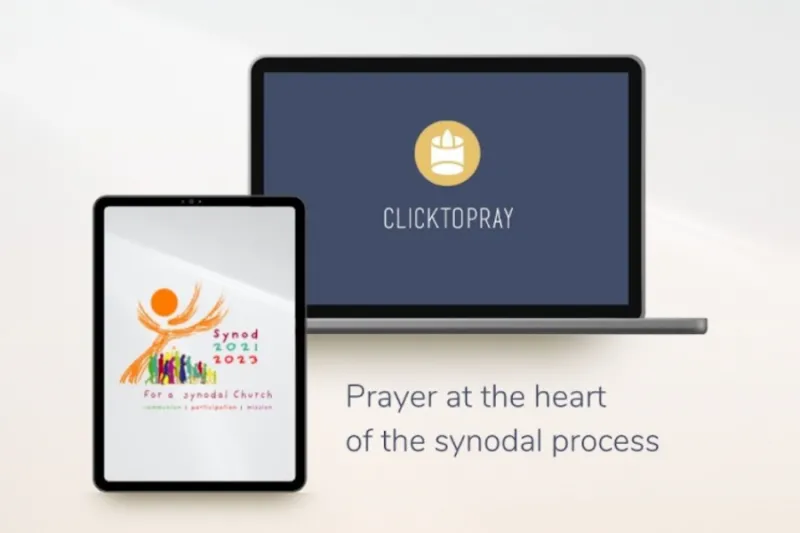
Vatican City, Oct 20, 2021 / 05:03 am (CNA).
The Vatican on Tuesday launched a website and smartphone app to help Catholics pray for the success of the two-year process culminating in the 2023 synod on synodality.
At prayforthesynod.va, Catholics can find information in English, Spanish, and other languages about how to support the synod through prayer.
“This website, together with the app Click To Pray, aims to accompany the synodal way for prayer,” the website says on its “About us” page.
“In order to ‘walk together’ and listen to the Holy Spirit we need to pray. There can be no synodal way without personal and community prayer. Prayer prepares our hearts to listen carefully to others and helps us to discern the action of the Holy Spirit throughout the world.”
One way the Vatican has suggested that Catholics and their communities can pray for the synod is by reciting a prayer to the Holy Spirit, a simplified version of the “Adsumus, Sancte Spiritus.”
The “Adsumus, Sancte Spiritus,” according to the “Pray for the Synod” website, was prayed at the beginning of every session during the Second Vatican Council.
The prayer was revised “so that any group or liturgical assembly can pray more easily,” the website states.
The synodal process, launched by Pope Francis earlier this month, is a two-year, worldwide undertaking during which Catholics will be encouraged to submit feedback to their local dioceses.
A synod is a meeting of bishops gathered to discuss a topic of theological or pastoral significance, to prepare a document of advice or counsel to the pope.
The Vatican has also unveiled version 2.0 of the Click To Pray app, first launched in 2019.
The app connects Catholics to a global network to share prayer intentions via their smartphones — and will be another way to pray with others during the synodal process.
Speaking at a presentation on Oct. 19, Msgr. Lucio Adrián Ruiz, an official of the Vatican communications dicastery, said: “The novelties of the new platform propose a greater interaction with various networks and ecclesial communities, a new possibility for accompanying each other in a personalized way in our spiritual life.”
The Click To Pray network also has a website and is present on Facebook, Twitter, Instagram, and YouTube.
Using media and technology to live stream Masses and other prayers during the coronavirus pandemic showed us it can be a tool for unity, Ruiz added. “It’s a good and opportune instrument for this communion, because it offers a space of community and support in and for prayer.”
“It’s a great joy to be able to present on this day not only the new version of Click To Pray, but its dynamic opening to the process that the Church has begun to follow with the synod,” he said.
Bettina Raed, the international coordinator of Click To Pray, said on Oct. 19 that “Click To Pray is a community of prayer which helps us pray for the challenges of the world.”
“Click To Pray accompanies users in their personal and community prayer proposing a daily rhythm of prayer in three moments of the day: morning, afternoon, and evening,” she said.
Raed is also the regional director in Argentina and Uruguay of the Pope’s Worldwide Prayer Network, which is a sponsor of the app and prayer website for the synod, together with the International Union of Superiors General.
“The proposals are simple, concrete, and well adapted to daily life, in a way that people can pray for the necessities of the world in the middle of their everyday activities,” she said.
She added: “To help pray for the intentions of the Holy Father does not mean to only pray for his monthly intentions, but for all of the requests for which the Holy Father asks us to pray, and which are presented in his profile of prayer.”
If you value the news and views Catholic World Report provides, please consider donating to support our efforts. Your contribution will help us continue to make CWR available to all readers worldwide for free, without a subscription. Thank you for your generosity!
Click here for more information on donating to CWR. Click here to sign up for our newsletter.





Here’s a short tour through a few synods of yesteryear—the ones using the now-posted prayer Adsumus Sanct Spiritus (We stand before You, Holy Spirit).
This synodal prayer was first used at the Second Provincial Council of Seville, Spain, in A.D. 619. It was also used at the synodal Fourth Provincial Council of Toledo, Spain in A.D. 633; and then in the sessions of the First Vatican Council in A.D. 1869; and throughout Vatican II. The Canon itself was first defined by a local council (synod) in Rome in A.D. 382 A.D., followed by decrees assembling the bible, at the synodal Council Hippo in A.D. 393 and confirmed at the synodal Council of Carthage in A.D. 397 and again A.D. 419…And then forwarded by St. Augustine to Boniface, Bishop of Rome, for final confirmation.
An apostolic culture of service, but not quite an “inverted pyramid” of generic Christianity blended with the genuine, but lowest-common-denominator “good will” of all others.
In still earlier years, Bishop Apollinarius of Hierapolis presided over yet another synod (c. A.D. 177) condemning the “new prophecy” of Montanism—a sect claiming to live under the direct guidance of the Holy Spirit, prophets and prophetesses. A recurring temptation for some.
The most recent synods include Pope Paul VI’s lucid benchmark, Evangelii Nuntiandi (Evangelization in the Modern World, 1975). And, Pope John Paul II’s Extraordinary Synod of Bishops (1985) convened to recapture a clear and balanced understanding of both the spirit AND the texts of the Second Vatican Council, as “the Magna Charta for the future.”
As for this future, then, perhaps some local synods can “listen” to these most recent and clarifying two pieces, early in their discernment of 2021-2022?